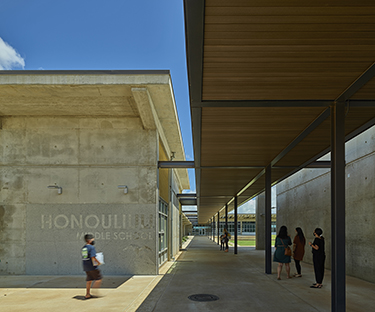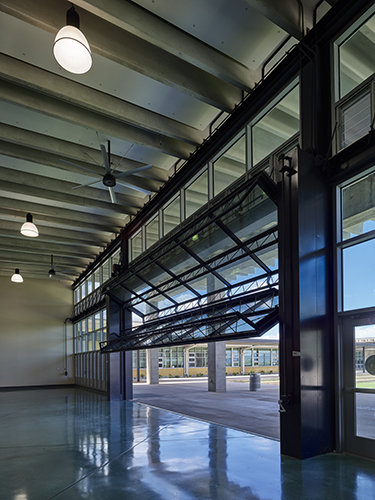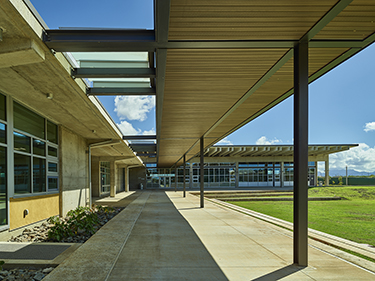|
Subscribe / Renew |
|
|
Contact Us |
|
| ► Subscribe to our Free Weekly Newsletter | |
| home | Welcome, sign in or click here to subscribe. | login |
Construction
| |
 |
September 30, 2021
Effective learning design in the state-of-the-art Honouliuli Middle School
The Miller Hull Partnership

Popolow
|
When the Hawaii Department of Education set out to create a 21st century educational facility that would be economical to construct, provide superior learning environments, and be cost-effective to operate and maintain, it selected The Miller Hull Partnership and Ferraro Choi Architects to collaborate in the design. Phase one of the Honouliuli Middle School, located on an 18-acre parcel in Honolulu, was completed and occupied in 2021, with two additional construction phases planned to complete the campus serving 1,050 students.
Miller Hull was charged to lead the planning process, design the shell and core, and provide expertise on 21st century learning environments. The local firm, Ferraro Choi, led the project team and was responsible for the design of the interior environments. The two architecture firms worked in a collaborative manner resulting in an integrated design.
Throughout the design process, Miller Hull presented progress reflecting the client’s overarching goals: budget, thermal comfort, long-term maintenance, and safety and security. At the same time, the firm needed to design effective learning environments that set students up for success as adults.
The first phase of the middle school included administration functions, a library, cafeteria and kitchen, music program, an outdoor covered basketball court and adjacent tennis courts, and one of three classroom buildings. Site work included the main exterior plaza, a centrally located grassy outdoor commons, parking, loading dock and stormwater infrastructure. Phase two and three are currently under construction, with phase two including the second of the three classroom buildings and the soccer field, and phase three including the last of the classroom buildings and a baseball field.
COMMUNITY PROCESS
The Department of Education desired a cohesive, integrative, collaborative and highly successful design process that could serve as an example for future DOE projects. Miller Hull crafted an initial and unique charrette process that was facilitated by an impartial third party and included a series of three intensive on-site workshops between the design team, the client group, and a larger stakeholder group including students, parents, teachers, school administrators, staff, community and business representatives. The goal was to, together, define an early common vision and vested interest in the project. Information was collected via meetings, presentations, feedback sessions, surveys, and other exercises to create a comprehensive list of expectations and opportunities specific to the project.
DESIGNING FOR SUCCESS
The school’s main entry plaza welcomes students, faculty and community members through a single-entry point to the campus. The shaded covered walkway leads into the heart of campus, reinforcing the concept of one front door and strengthening the identity of place through a shared sense of belonging.
The campus is made up of a collection of separate buildings organized around a central outdoor common area. This organizational strategy recognizes that middle schoolers’ network of influence shifts from family to friends and the importance of having space that they can treat as their own in this important stage of development. By focusing communal programs around the outdoor commons, these shared spaces thrive at the heart of campus and promote the sharing of resources and ideas building off each other.
Architectural elements throughout campus are designed to perform multiple functions as a strategy to reduce cost and maintenance. For example, the large shutters primarily operate to shade the classroom windows throughout the school day. After hours, the shutters are closed to provide security in front of the jalousie windows, which remain open for night flush cooling.
More of these examples can be seen throughout the project. Exterior materials were selected to provide high visibility, provide solar control, limit heat gain, and be durable with low-maintenance needs. Exposing the structure to view as the finish material eliminates the need for secondary materials. A large, motor-operated bi-fold door at the cafeteria and adjacent operable windows naturally ventilate the large cafeteria, allowing for the extension of the cafeteria to the commons for an indoor/outdoor connection while providing a flexible venue to accommodate a range of event sizes.
The climate in Kapolei, Hawaii, is very hot and dry with 18 inches of rainfall per year. There is a consistent northeast trade wind that offers an important natural opportunity to assist with cooling. Hawaii’s schools have historically been known for hot and uncomfortable classrooms during much of the school year — contributing to poor academic performance.
The campus was planned to situate high-use spaces suitable for natural ventilation on the windward side of buildings — oriented perpendicular to the trade winds for optimal cross ventilation and comfort under the ASHRAE Standard 55 Adaptive Thermal Comfort Model. This allows for a mixed-mode approach that relies on natural ventilation for all but four months of the year when air-conditioning is required. During warm weather, multiple low-maintenance VRF air-conditioning systems provide cooling. CFD wind analysis software assisted in confirming optimal locations for buildings relative to one another, location and quantity of operable windows, and the impact of air velocity on occupants.
Roof overhangs shade 100% of glazed areas, and large operable shutters allow the program to flow from interior to exterior seamlessly. Sun studies in Revit were used to confirm these goals were met. Covered walkways and vertical sunscreen slats provide shade to students and faculty as they gather at outdoor learning lanais and move throughout the exterior spaces on campus.
MATERIAL USE
Availability of construction materials is challenging in Hawaii, as is finding materials that are resistant to the harsh marine environment and termites. The design team worked with local suppliers to develop a simple material palette of locally available and robust materials: precast concrete, masonry, stucco, and aluminum bi-fold shutters. Shipping materials to Hawaii is costly and time-consuming and buying local puts public construction funds to work in the local community.
Concrete was selected as the primary building material for its local availability and serves to unify the collection of buildings on campus. The expressed structure doubles as a low-maintenance exterior finish and the material’s thermal mass contribute to the success of a simple passive solar cooling system.
Katie Popolow joined Miller Hull in 2000 and serves as the managing principal of the San Diego studio.
Other Stories:
- Nature and nurture in Renton's Cascade/Benson Hill neighborhood
- Exploring the benefits of mass timber
- School ventilation strategies for a pandemic
- How schools and designers can manage crises
- Strategic energy planning for equity and resilience
- Providing for diversity in K-12 schools
- Trauma-informed design in schools
- Progressive design-build is changing the future of K-12 construction





